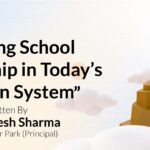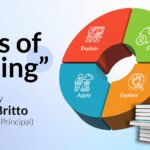Today, the pandemic has brought forth that e-Learning is the need of the world. In this, the digital era, many sectors, departments, industry, regions, and countries are following the e-Learning concept for education, training and evaluation purposes.
In my opinion, e-Learning is not just an electronic transfer of content; it is a different way of presenting and teaching content to interested learners. It is a medium of transferring knowledge, not content and syllabus.
E-Learning is not just limited to content alone, it goes beyond that. To understand the impact of e-learning, let us take an example of a movie. If you give the script of a movie or a novel to someone and ask him/her questions based on them, 99% of the people will not be able to give answers to all the questions. However, if the same novel or script is converted into a movie, the same people will be able to answer 99% of the questions. The content, context and story are all the same, but the results vary.
E-Learning, without a doubt, has fixed its roots in the surface of education. With the increasing speed of internet connections, opportunities for multimedia training have arisen. Even social media has left a great impact on education and is evolving it constantly.
Several eLearning trends can give us a clear and bigger picture of the future of e-Learning, and how the tools will be shaped.
The Trends Are As Follows
Microlearning: Microlearning is increasingly gaining its popularity in the world of learning and development. It helps the students to learn a small and necessary amount of useful information about a particular subject. It provides information to the professionals when they need it saves everyone’s time and increases ROI. In today’s world, people have no to get their jobs done and participate in training programs. Microlearning provides them with solutions to all the problems which eventually help them to do their jobs even more efficiently.
Video Modules: Being similar to microlearning, videos are even a more popular and accessible way of delivering online courses. This way of delivering courses can provide a wide variety of subjects to a larger audience. It makes it easier to learn and educate.
Tailored Learning Paths: Everyone, on the surface of the earth, has different learning needs. Through advances in digital technology, it is possible to create adaptive learning solutions. Course providers can modify according to the abilities and needs of different learners.
Modular Short e-Courses: From traditional resources to vast tranches of online knowledge, learning providers lay down a massive amount of content. The resources are tailored according to one’s needs and relevant to the learners in the challenge. Courses are changed with the entrance of the new course to the surface. Matching steps with the changing courses, information is adapted and delivered according to the learning needs.
Learning Management System: The most practical way to keep track of learners and educators is Learning Management Systems (LMSs). An LMS is emerged from eLearning and mostly used in higher studies sector and corporate firms. It is very helpful in the documentation, reporting, and administration.
Learning Communities: Students tend to be more social online than in the real world. Today’s generation is using numerous apps for learning activities without any school involvement. E-Books, apps and other digital relearning materials are easily accessible and easy to carry, unlike the traditional learning materials. A large number of people supports E-Learning services, and it is considered modern student preferences.
As much as eLearning is being supported, it is hard to take its roots out of the surface of Learning and Development. E-Learning is an affordable solution to learners as it provides them with the ability to gain qualifications. Education has developed to its peak and beyond with the arrival of the internet. Today’s generation is well versed in the use of technologies, smartphones, text messaging and using the internet. This has made it easier for the generation to access online courses. It is like on their fingertips.
High quality content, polished design and easy navigability are three important ingredients of any successful e-learning course. However, one of the most essential elements of an e-learning course design and development is often overlooked; and that is no other than interactivity.
Mr. Mukesh Sharma: Mr Mukesh Sharma is the Principal of RIS Patankar Park. He has been in the field of education since the past 30 years. He has his expertise set in academics and administration. His working profile has included his service in all curriculums – CBSE and State Board. Winning many accolades, he has received a commendation from the Minister of Education (then Ministry of Human Resource Development), Government of India’s office for the commendable academic performance of students at Board exams. He has also worked in different capacities i.e as an Inspection Committee member for Affiliation unit, Centre Superintendent for conducting JEE Mains and NEET by NTA.










